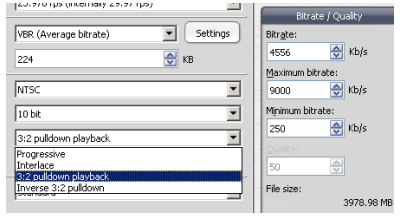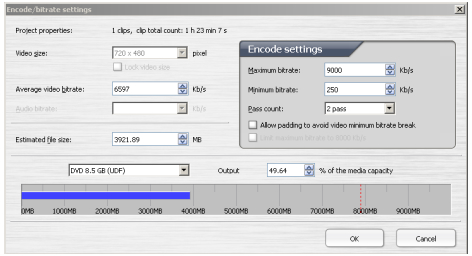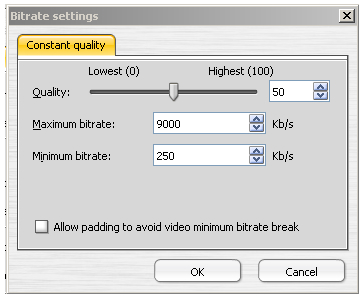The Video Tab
The options on the Video Tab vary greatly depending on a few key selections, the first of which is whether you're encoding to MPEG-1 or MPEG-2 format. Unless you're authoring a VCD of some kind or very low resolution and low bitrate progressive DVD content, you should stick to MPEG-2 encoding. If you do need to encode MPEG-1 however, TMPGEnc XPress is as good as any encoder available.
Profile@Level

MPEG-2 encoding is categorized according to features available to the encoder and decoder (profile) and range of values for certain options within those features (level). The combination of a level and profile is referred to with the notation of Profile@Level, and both are often abbreviated, like MP@ML (Main Profile@Main Level) or MP@HL (Main Profile@High Level). MP@ML is used for DVD-Video and SVCD. It will allow you to encode standard D1 resolution video for either PAL (720x576) or NTSC (720x480) and use bitrates up to 15Mbps. MP@H14 would be appropriate for 720p hi-def or HD camcorder footage. MP@HL is suitable for 1080i or 1080p video. Main Profile indicates the use of B frames, which Simple Profile doesn't support, and 4:2:0 colorspace.
Basic Frame Information
Size
The resolution of the output video file is indicated by a size in pixels. Although you can change the resolution using TMPGEnc XPress, you may want to do it ahead of time, either by encoding an intermediary file with another tool or using AviSynth to resize on the fly.
Aspect Ratio
Aspect ratio can be set either for each pixel or an entire frame. Depending on whether you're encoding to MPEG-2 or MPEG-1, most of your choices will be different. The exception is called Pixel 1:1. Selecting this for aspect ratio makes the AR equal to the resolution of a frame. As with all pixel aspect ratios, adding rows or columns of pixels will alter the aspect ratio of a frame. MPEG-1 also gives you the option of Pixel 4:3 NTSC or PAL and Pixel 16:9 NTSC or PAL to be used for various television screens. MPEG-2 gives you choices of Display 4:3, Display 16:9, and Display 2.21:1, indicating the aspect ratio signalled for the entire frame. Changing the resolution has no affect on AR in this case.Framerate
Framerate for each file can be set to 23.976fps, 24fps, 25fps, 29.97fps, or 30fps. MPEG-1 video adds framerates of 50fps, 59.94fps, and 60fps. This should normally be set to 25fps for PAL, whether it's film based content or actual video. For NTSC it will depend on whether your source is 23.976fps film frames or 29.97fps video or telecined film. Simply match the output framerate to the source. Rate Control
Rate Control
MPEG-2 and MPEG-1 have three methods available to control bitrate and quality. Two of them, Constant Bitrate (CBR) and Average Bitrate (VBR) set quality based on allocating a fixed number of bits. Constant bitrate is useful for low bitrates where everything will need the maximum available. It's more likely to be used for MPEG-1 encoding than MPEG-2. Average Bitrate is commonly used for SVCD and DVD encoding because it allows higher peak bitrates for more complex scenes by limiting bitrate in other places. The last option, Constant Quality, sacrifices predictable output size for an attempt to maintain the same quality in all parts of the video.
Bitrate/Quality Settings
Settings for each Rate Control Mode can be accessed either from the lower right side of the Format window or by clicking the Settings button to the right of the Rate Control Mode selection dropdown list. The Settings button calls up a dialog that can help you compare your output to a particular media size. You may notice that there are multiple listings for certain CD sizes. ISO represents the size of a CD burned in data mode, which is used for both data CDs and standalone player formats from DVD forward. VCD and SVCD are written with less error correction, and can therefore store more data on a CD. CD size is listed in minutes for these options because it's based on the CD Audio format. There are different dialogs for each mode. The Bitrate/Quality area of the Format window allows you to set the minimum, maximum, and average bitrates, and shows you the resulting file size with no comparison to a particular size of media.
Average Bitrate Dialog
By adjusting the bitrate, you can see both the size of the output file, and the percentage of the selected media it will require for storage. Another option is to adjust the percentage to set the average bitrate. Maximum and minimum bitrates for the video stream can also be assigned here.
Constant Bitrate Dialog
The only variable value to set is the bitrate, which can either be directly changed, or changed through the percentage of the selected media to be used.
Constant Quality Dialog
Quality can be changed with a slider that goes from 0 (lowest quality) to 100 (highest quality) or directly entered. Minimum and maximum bitrates can also be set.Video Details

Generally you can set the Video Setting to either NTSC or PAL, depending on what format your video is. If you're just encoding for authoring later you're generally safe setting it to Unspecified.
DC Component Precision
DC Component Precision represents the accuracy of the calculations for Discrete Cosine Transforms, also known as DCT. Higher values will result in more accurate reproduction of the source, while lower values will lower the bitrate slightly. If you're source is an MPEG-2 file there's no benefit in encoding with a higher precision than the source.Display Mode
Display Mode refers to the interlacing properties of the video. PAL video will use either Progressive or Interlace, while NTSC video will almost never use the Progressive setting. Instead, progressive content from film will need to be set to either 3:2 Pulldown Playback if your source is at 23.976fps already or Inverse 3:2 Pulldown if you want TMPGEnc XPress to detect the pulldown flags and encode accordingly. Interlace should be used for NTSC video unless it's been deinterlaced.Field Order
When there's interlacing in the source you need to specify whether the top or bottom field should be displayed first. Specifying the wrong field order will make motion between fields jerky.
Motion Search Precision
Higher levels of Motion Search Precision do a better job of distributing bitrate, resulting in higher quality at the cost of longer encode times. The best way to determine what setting is right for you is to try more than one and compare them.

